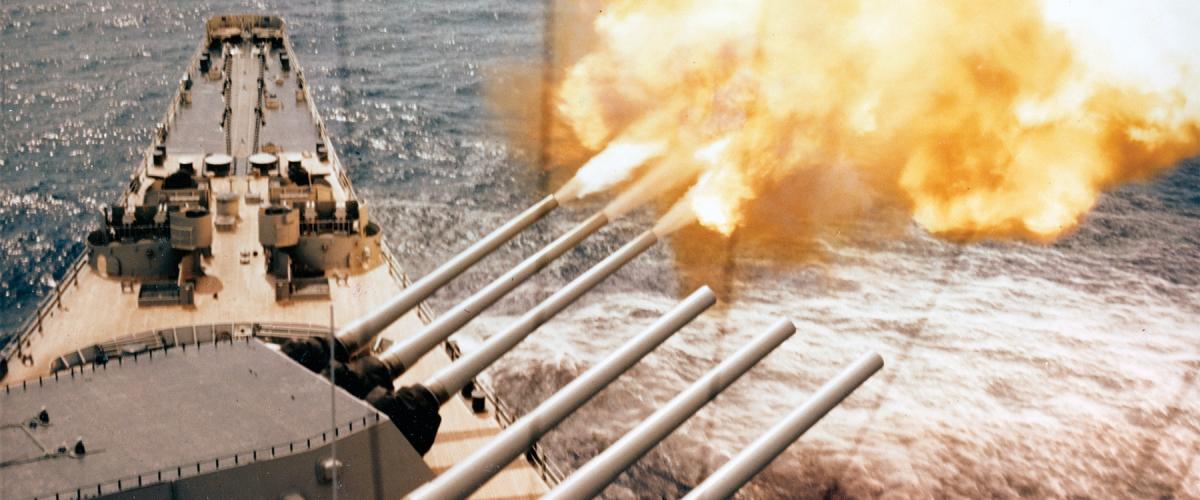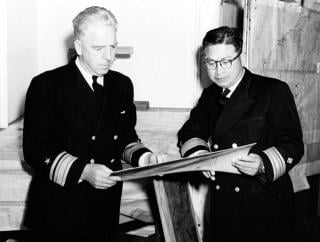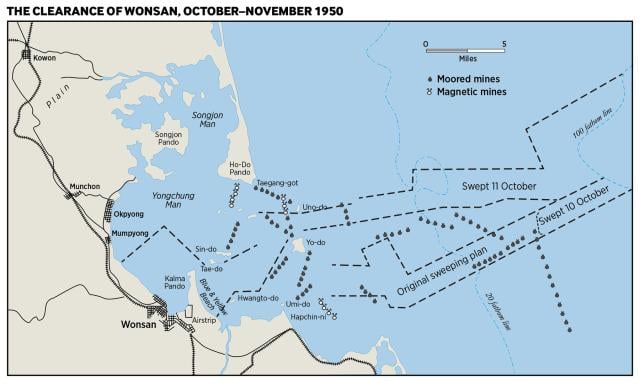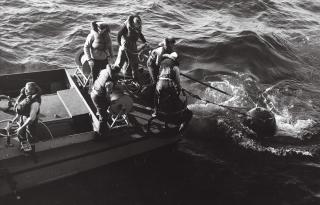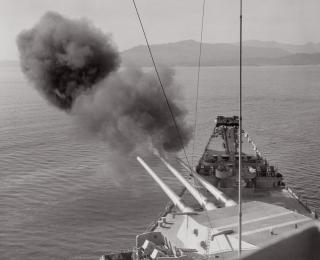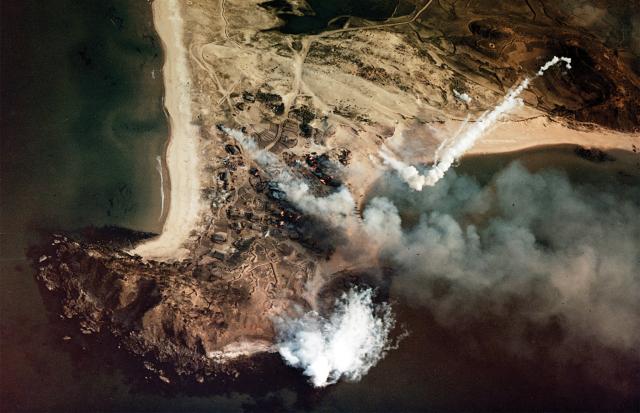Remembrance of naval power in the Korean War often centers on Task Force 77 carrier planes helping beat back the North Korean invasion of the Republic of Korea (ROK), the Seventh Fleet’s brilliantly executed amphibious landing at Inchon, the 1st Marine Division’s fighting withdrawal from the Chosin (Changjin) Reservoir, and the Navy’s successful evacuation of 200,000 troops and refugees from Hungnam, North Korea—all of which took place in 1950.
Few casual observers can recollect significant naval events that occurred during the long period from early 1951 to the end of the conflict on 27 July 1953. The U.S. Navy’s official history of the war analyzes the events of 1950 in more than 300 pages while covering much of the latter period with the decidedly uninspiring and revealing chapter heading, “Two More Years.”1
Yet, from 1951 to 1953, the U.S. and other United Nations navies executed a campaign that brought heavy and sustained sea power to bear on the eastern coast of the Democratic People’s Republic of Korea and the North Korean and Chinese troops garrisoning that Communist country. The naval contribution to the fight during the years from 1951 to 1953 significantly enhanced the United Nations’ successful strategy to end the war while preserving the sovereignty of the Republic of Korea.
Mission: Isolate Wonsan Harbor
The most dramatic operation of the overall naval campaign was the 861-day Siege of Wonsan. That port on the Sea of Japan and its many harbor islands were not the singular focus of allied leaders as the UN ground forces launched a northward counteroffensive in the early months of 1951. Indeed, Rear Admiral Allan E. “Hoke” Smith, commander of the UN Blockading and Escort Force (Task Force 95), considered the many islands on both coasts of Korea as potential staging bases for offensive action in support of the ground campaign. He knew that the allies had driven the North Korean Navy from the sea at the outset of the war and dominated the air space over the peninsula, especially in the east.
Hence, U.S. and allied naval and air forces had the ability to closely invest the enemy-held coastlines. Smith’s in-theater naval commander, Vice Admiral C. Turner Joy, Commander Naval Forces, Far East, readily endorsed the overall concept, as did General Douglas MacArthur, Commander-in-Chief, Far East, and Matthew B. Ridgway, Commanding General of the U.S. 8th Army.
But Wonsan’s strategic importance soon drew their attention. An extended siege could deny North Korea use of one of its most vital ports and centers of industrial and economic activity. Unlike other sites on the east coast, the 300-square-mile Wonsan Harbor remained ice-free throughout Korea’s notoriously frigid winters. Many islands served as wind-breaks, protecting the harbor from the typhoons that routinely swept the Sea of Japan. The prewar city of 100,000 souls hosted many defense-related industries, including a 4 million-square-foot petroleum refinery, heavy metal plants, and a railway repair factory. Port facilities included a 900-foot concrete wharf, a 40-ton crane, and numerous warehouses and piers. An airfield also served the city. Fleets of fishing boats based in Wonsan plied the waters of northeast Korea to sustain not only the country’s population but also its combat forces.
Wonsan also was the east coast anchor of the road and rail lines that traversed the country from the capital, Pyongyang, and extended north to the border with the Soviet Union. South through Wonsan passed the supplies of guns, ammunition, fuel, and food needed by Communist forces fighting UN troops at the 38th parallel. Allied occupation of the harbor could severely limit the enemy’s use of the sea for sustenance. A siege could enable the allies to threaten another game-changing, Inchon-like amphibious assault behind the enemy’s lines, compelling the Communists to hold large forces in reserve for that eventuality. Those forces would not be readily available to fight U.S. and other UN troops at the 38th parallel.
Further, the islands in the harbor could operate as bases from which allied commandos and intelligence agents could attack sites on the mainland and gather information on enemy activities. The port also could serve as a logistic hub if UN forces decided to invade North Korea from the sea and mount another advance to the Yalu River. Finally, a siege of Wonsan promised to show the international community and the other U.S. armed services that sea power could make an even more significant contribution to the ground and air campaign in Korea.
On 16 February 1951 and in succeeding days, the U.S. light cruiser Manchester (CL-83), U.S. destroyer Ozbourn (DD-846), and British light cruiser Belfast bombarded targets ashore. On the 24th an ROK LST deployed 110 South Korean marines on Sin-do, only 4,000 yards from Kalma Pando, a peninsula on Wonsan’s doorstep. Facing no opposition, UN forces soon occupied more islands in the harbor, including Yo-do, Tae-do, and Hwangto-do. Thus began the Siege of Wonsan.
Junks, Sampans—and Soviet Mines
Yo-do, the largest and most distant harbor island from North Korean–held territory, soon became the main base of operations. U.S. Navy Seabees later built an airfield on the site. The defense force included U.S., British, and South Korean marines. In mid-March 1951, the North Koreans made an attempt to counter the allied island occupation operation, sending a sampan loaded with troops to seize Tae-do. U.S. destroyer gunfire ended that effort.
Hwangto-do, only 3,000 yards from Kalma Pando, served as the allies’ most important site for calling in fire on enemy activity in Wonsan, at the nearby airfield, and along adjoining road and rail lines. The North Koreans were decidedly unhappy with allied forces operating so close to the city. On 28–29 November, sampan-borne troops raided the island, killing or capturing seven ROK marines. To prevent a recurrence, the initial contingent of South Korean marines was reinforced with naval shore fire-control parties and U.S. Marines.
Admiral Smith’s immediate priority was to clear North Korean contact mines from Wonsan Harbor and keep those waters free of the lethal weapons. The flag officer was well aware that Soviet-supplied contact mines laid by enemy sampans and junks in October 1950 had delayed the planned landing of the 1st Marine Division at Wonsan for weeks.
Moreover, during that month mines sank the auxiliary minesweeper USS Magpie (AMS-25) and fleet minesweepers Pirate (AM-275) and Pledge (AM-277), with heavy loss of life. In the aftermath of those tragic episodes, Smith lamented memorably to Admiral Forrest Sherman, the Chief of Naval Operations, “We have lost control of the seas to a nation without a Navy, using a pre–World War I weapon, laid by vessels that were utilized at the time of the birth of Christ.”2
For the duration of the siege, 31 U.S. and 10 ROK minesweeping ships served in the Wonsan Defense and Blockade Unit (Task Unit 95.2.1). The vessels included DMS destroyer minesweepers, AM minesweepers, AMS auxiliary motor minesweepers, LCVP landing craft, motor launches, and, later in the war, helicopters employed for spotting mines. At any given time, the unit operated with four or five minesweepers and two or three destroyers, detailed to that duty for a month. Even after the allied ships cleared mines from the harbor, enemy sampans routinely put more in the water. The North Koreans also attached mines to oil drums, logs, or other floating materials.
The mine clearance force removed hundreds of mines from the harbor, but the enemy weapons continued to take a toll. During 1951, mines damaged the destroyers USS Walke (DD-723) and Ernest G. Small (DD-838) and killed 35 of their sailors. And on 26 December 1951, a mine struck ROK PC-704 off Yo-do, sending the vessel and 20 of her sailors to the bottom. During 1952 and 1953, mines detached from their mooring devices sank the fleet ocean tug Sarsi (ATF-111) and damaged the destroyer Barton (DD-722), although these events occurred away from waters cleared of thousands of mines by the allies.
Smith deployed other warships into the harbor to protect the minesweepers from enemy fire and to blast the rail and road lines that spanned the city and Wonsan’s factories, supply depots, and barracks. One contingent consisted of medium rocket landing ships (LSMRs) that could put out a lot of fire in a short time. On the night of 20–21 May 1951, in just a 35-minute period, LSMR 401 and LSMR 403 fired 5,000 rounds at targets ashore.
Firepower Unleashed
U.S. and allied destroyers were the mainstays of the Wonsan siege. Well-trained and efficient crews manning 5-inch/38-caliber guns could shoot 20 rounds in a minute. During two weeks in June 1951, for instance, the four ships of Destroyer Division 52 fired more than 8,000 rounds from their guns.
Seventh Fleet heavy gun cruisers also operated in Wonsan Harbor, taking targets ashore under direct fire and at short range. The 8-inch gun warships proved especially effective at taking out lucrative targets.
On one occasion, the heavy cruiser USS Los Angeles (CA-135) discovered a North Korean train and a battalion of troops in the open. The ship’s guns obliterated 12 boxcars loaded with ammunition and inflicted more than 100 casualties on the enemy ground unit. A commanding officer of the Helena (CA-75) remembered his ship hitting an enemy artillery piece “absolutely square on. . . . You could see wheels and parts flying in the air—we really clobbered it.”3
The most impressive surface warships ever built for the U.S. Navy added their considerable firepower and defensive strength to the Wonsan siege. The four battleships of the Iowa class—the USS Iowa (BB-61), New Jersey (BB-62), Missouri (BB-63), and Wisconsin (BB-64)—each armed with nine 16-inch naval rifles, could collapse caves and other redoubts from which enemy gun batteries attacked ships in the harbor and erase any battery caught in the open. And by the end of the siege, naval gunfire had leveled most of Wonsan’s port facilities, factories, and barracks. The Iowa-class ships fired more than 20,000 rounds during the war, mostly on the east coast.
An equally positive attribute of the battleships was their thick armor that proved impervious to the North Korean army’s coastal batteries, mostly composed of field artillery pieces. An enemy round that hit the New Jersey’s forward gun turret in May 1951 caused only cosmetic damage. In another round, however, an air burst killed one sailor and wounded three other men. The captain of one battleship actually welcomed enemy fire so he could pinpoint and then neutralize his attackers.
Confident of their ships’ ability to survive enemy fire, battleship commanding officers frequently dropped anchor within 2,000 yards of the peninsulas from which many of the enemy guns operated. On most occasions, when U.S. and allied battleships and cruisers entered the harbor, the enemy’s guns wisely remained silent. In September 1952, General Mark Clark, Commander-in-Chief, United Nations Command; Vice Admiral Robert Briscoe, Commander Naval Forces, Far East; and Vice Admiral Joseph J. “Jocko” Clark, Commander Seventh Fleet, watched from the Iowa as her guns fired on a nearby enemy site, causing a “magnificent secondary explosion” and resulting in “these particular guns [being] permanently silenced.”4
Unlike the battleships, however, the other naval vessels working in the harbor risked being sunk or heavily damaged by enemy gunfire. The low-speed, unarmored, and lightly armed minesweepers and LSMRs were endangered by mines and shellfire. Initially, allied ships anchored in the harbor to aid their shooting accuracy and reduce their chances of steaming into a mine. The growing number of enemy guns, however, made that tactic risky.
Since most of the enemy’s guns were not designed for coastal defense against ships on the move, their fire was not particularly accurate. In November 1952, for instance, 174 enemy rounds splashed around the destroyer minesweeper USS Thompson (DMS-38) before one struck home. But during the siege, enemy gunfire did hit 44 UN ships. Allied leaders feared that sooner or later enemy fire would sink a ship. Commander John V. Smith, a Seventh Fleet staff officer, observed that it was “almost like operating in the upper Chesapeake Bay [since the enemy] could shoot at us from all sides. . . . This was a siege from the inside out.”5
In 1952, Rear Admiral George C. Dyer, Commander Task Force 95, “made it compulsory that at all times in daylight and for all bombardments, either night or day, ships should be underway.”6 Mines and enemy gunfire were not the only concerns for the ships and sailors operating in the harbor. On 21 April 1952, the heavy cruiser Saint Paul (CA-73), one of the stars of the bombardment effort, suffered an explosion in an 8-inch turret that killed 30 men.
Cutting Off the Land Routes
In addition to protecting ships in the harbor, the battleships, cruisers, and destroyers focused their efforts on interdicting the roads and railroads that radiated from Wonsan to the north, south, and west. The surface ships worked in conjunction with Task Force 77 carrier planes to take out railways, bridges, and other targets that could not be seen from the harbor. The Taebak Mountains that rose behind the port masked gun positions, railroad tunnels, and transportation routes farther inland. The ships helped the attack squadrons by bombarding antiaircraft batteries and firing illumination rounds at targets during nighttime operations. In June 1951, for instance, the destroyer USS John P. Kennedy (DD-850) lit up a convoy of 200 trucks that attack planes then decimated.
A hundred days after the onset of the siege, Admiral Smith reported that allied surface warships and carrier aircraft had inflicted 8,000 casualties on enemy units and destroyed or damaged 300 trucks, 100 bridges, 100 locomotives and boxcars, 300 small boats, and 600 of Wonsan’s warehouses and other military-related structures. The allied navies continued to take a heavy toll on North Korean resources in and around the port.
The Siege of Wonsan did not sever enemy supply lines through the port. By the end of the conflict, some trains and truck convoys continued to survive UN fire and make their way south in their mostly nighttime forays. They were assisted in that mission by as many as 20,000 enemy military personnel and civilian laborers who repaired bridges, single-track railways, and the dirt roads that predominated in North Korea, sometimes in only hours or days.
The North Koreans, however, were compelled to divert military resources badly needed at the 38th parallel and on the west coast to defend Wonsan and the transportation network of eastern North Korea. The enemy increasingly positioned artillery pieces, self-propelled guns, and even tanks in caves or on railway flat cars, and heavier guns and antiaircraft weapons in the hills around the city. By 1952, more than 1,000 coastal and antiaircraft guns, or 55 percent of the North Korean inventory, defended the port. Many of the weapons were radar-guided, able to hit targets ten miles distant, and employed proximity-fuse shells for air bursts over ships.
Fear of Another Inchon
Throughout the war, the Communist command kept from 60,000 to 80,000 North Korean troops in reserve to thwart a feared UN amphibious assault. Over the years, veteran Communist military leaders have acknowledged that they were especially concerned about the possibility of another Inchon-like surprise. To heighten that fear, on several occasions UN forces mounted seaborne feints and demonstrations. For three days in August 1951, a battleship, cruiser, and four destroyers bombarded targets ashore near Changjon, southeast of Wonsan, after which four amphibious ships launched empty landing craft toward the shore.
The North Koreans, knowing that the highly trained and veteran 1st Marine Division was then fully committed on the frontline at the 38th parallel, did not immediately rush troops to the shore. But they could not be complacent since the Seventh Fleet earlier in the war had landed troops of the non–amphibious-trained 7th Infantry Division at Inchon and ports on the Sea of Japan. The same lack of an immediate enemy response attended the appropriately named Operation Decoy of October 1952 that involved 100 UN ships, three days of shelling at targets around Kojo, and then the launch and retrieval of empty landing craft.
Always worried about an amphibious assault, when the battleship bombardments and carrier strikes ramped up, the North Koreans could be counted on to respond with furious counterbattery fire from the guns around Wonsan. Rear Admiral Dyer remembered that twice during his service as Commander Task Force 95, some officers wondered if the Wonsan operation was having enough of an impact on the enemy, and was worth the hardships being endured by ships and sailors, to warrant its continuation. Dyer asserted that “the best brains in the Army and Navy—Forrest Sherman, MacArthur, Ridgway—were all convinced of the necessity of the siege.”7
As Admiral Smith had envisioned, the islands in the harbor served as launchpads for operations to sabotage targets ashore, gather intelligence on North Korean forces, and cripple the enemy’s east coast fishing activity. Vice Admiral Harold M. Martin, Commander Seventh Fleet after March 1951, related that “one division of destroyers supported [the intelligence units on the harbor islands] and supplied them with materials used for buying intelligence information ashore, especially wool socks and soap.” He added that “their secondary chore was to support the activities of the CIA.”8
Secreting Spies to Shore
In so-called “Comber Operations,” destroyers served as “mother ships” to deliver intelligence agents ashore. The destroyer USS Wallace L. Lind (DD-703) carried out 38 such nighttime operations in the vicinity of Wonsan during the early months of 1951. In these especially dangerous operations, a 26-foot motor whaleboat towing a rubber raft would launch from the ship carrying the spies. The raft would deposit the men on the beach. On some occasions, enemy coastal defense troops were there to meet the clandestine operators, with tragic consequences for the latter.
Some destroyer skippers used their whaleboats to target North Korean fishing vessels. Commander James A. Dare, the captain of the USS Douglas H. Fox (DD-779), routinely deployed his whaleboat filled with heavily armed sailors to seize fishing boats, destroy their nets, and bring the captured fishermen back to the destroyer for interrogation. The temporarily detained fishermen often willingly provided intelligence on the location and weaponry of enemy forces ashore.
To emphasize the point that UN naval forces were operating in strength only a few miles from North Korea and one of its major ports, on 1 May 1952—International Labor Day celebrated in Communist countries—Dare’s whaleboat sailors planted an American flag in a prominent location on a harbor island so enemy eyes could easily see it.
UN warships, sometimes using surface-search radar, also targeted coastal craft that the North Koreans used to transport supplies to their troops defending the coast or to the fighting front to the south. During the latter months of 1952, allied naval forces sank or damaged close to 200 junks and sampans. A Pacific Fleet study done after the war concluded that unlike the aerial interdiction effort, the coastal blockade was especially effective. Destroyers and other ships also deposited special forces teams on the mainland and enemy-held islands near Wonsan and all along the eastern coast to destroy supply dumps, bridges, railroad tracks, and railway tunnels that the enemy used to protect trains from allied naval gunfire and air attack.
Wonsan Harbor also became invaluable for the UN effort to save allied airmen whose planes had been shot from the skies by the enemy’s lethal antiaircraft defenses. Initially, naval leaders deployed LST-799 near Yo-do to serve as a platform for two Sikorsky HO3S helicopters of Helicopter Utility Squadron 1. The helicopter crews were tasked with spotting and, on occasion, exploding mines with rifle fire. The Navy also deployed two older LSTs, crewed by contracted Japanese civilians, to serve as helicopter carriers.
It soon became apparent that the helicopters not only could hunt mines but also pluck from the harbor those aviators who managed to make it to the coast before bailing out. Helicopter pilot Lieutenant (junior grade) John K. Koelsch, who later received the Medal of Honor for his extraordinary courage ashore, in June 1951 rescued a downed flier near Yo-do. Commander Paul N. Gray, the highly decorated commanding officer of Fighter Squadron 54, earned the dubious distinction of being the only aviator rescued from the harbor three times. By the end of the war, the helicopter force had rescued 24 downed aircrewmen.
Ground Campaign’s Support from the Sea
In summary, the Siege of Wonsan enabled the naval forces of the United States and its UN allies to make a meaningful contribution to the ground and air campaign. The allied investiture of Wonsan compelled North Korean and Chinese forces to husband their reserves lest another amphibious assault once again change the course of the war. UN naval gunfire and air attacks did not stop the flow south of troops and war materials, but they severely diminished the enemy’s logistic effort and denied the fighting front artillery, antiaircraft guns, and other critical resources.
By the end of the war, allied fire had almost leveled Wonsan and drastically reduced its military and economic output. The blockade stifled fishing activity and reduced coastal movement to a trickle. Allied occupation of the harbor and its islands enhanced the ability of commandos and intelligence agents to operate behind enemy lines. The harbor also facilitated the helicopter search-and-rescue effort that retrieved many aviators from the sea. Hence, the U.S. and allied sailors who fought and sacrificed off Wonsan did so in service to an especially worthy and successful cause.
1. James A. Field, History of United States Naval Operations: Korea (Washington, DC: Naval History Division, 1962).
2. Quoted in Tamara Moser Melia, “Damn the Torpedoes”: A Short History of U.S. Naval Mine Countermeasures, 1777–1991 (Washington, DC: Naval Historical Center, 1991), 76.
3. Quoted in Malcolm Muir Jr., “Sea Power on Call: Fleet Operations, June 1951–July 1953,” in Edward J. Marolda, ed., The U.S. Navy in the Korean War (Annapolis, MD: Naval Institute Press, 2007), 401.
4. Muir, “Sea Power on Call,” 231.
5. Quoted in Joseph H. Alexander, “Fleet Operations in a Mobile War, September 1950–June 1951,” in Marolda, ed., The U.S. Navy in the Korean War, 231.
6. Quoted in Malcolm W. Cagle and Frank A. Manson, The Sea War in Korea (Annapolis, MD: U.S. Naval Institute, 1957), 410.
7. Quoted in Cagle and Manson, The Sea War in Korea, 414.
8. Quoted in Alexander, “Fleet Operations in a Mobile War,” 232.



